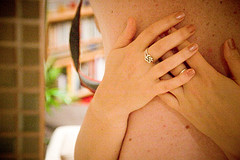 While on vacation last week, I had the opportunity (and the need) to do something I rarely do at home: Get a chiropractic adjustment.
The need was spurred by a headache subsequent to a 100-mile bike ride that saw me traverse Cape Cod from outermost Provincetown to downtown Hyannis, and back again. It was a pleasant trip, though exceedingly hot. And even though I ride a recumbent bicycle, which is far more comfortable for the neck over long distances than a standard upright, the recumbent in the extremely laid-back configuration can produce significant neck strain over time.
While on vacation last week, I had the opportunity (and the need) to do something I rarely do at home: Get a chiropractic adjustment.
The need was spurred by a headache subsequent to a 100-mile bike ride that saw me traverse Cape Cod from outermost Provincetown to downtown Hyannis, and back again. It was a pleasant trip, though exceedingly hot. And even though I ride a recumbent bicycle, which is far more comfortable for the neck over long distances than a standard upright, the recumbent in the extremely laid-back configuration can produce significant neck strain over time.
I was greeted on the morning following my ride, by a classic cervicogenic headache -- that is, a headache caused by the vertebrea in the neck becoming fixed in position. This is the cause of most headaches, which in the popular literature are often referred to as "tension headaches."
I had been needing an adjustment for some time, but like the average bad patient, I kept putting it off. In part, because most other chiropractic physicians work the same hours as myself, and in part because I've just been too busy. Sound familiar?
I was fortunate, however, to find that Dr. Donna Heitzman, in Provincetown, would have a few minutes to see me that afternoon. As Dr. Heitzman, a delightful woman with a puckish sense of humor, treated me, I was reminded of just how powerful the act of simply touching someone can be.
Arguments for the healing power of touch sends skeptics into paroxysms of denial, as healing touch is often so closely associated with fundamentalist religious practices, and the denial of the spiritual aspect of humanity is a fundamental tenet to the skeptic's belief system.
Nonetheless, there is a significant body of research which demonstrates the power of touch. Most recently, researchers found that the quality of objects that people were touching -- heavy vs. light, hard vs. soft, rough vs. smooth -- caused people to form unconscious associations between what they were touching and unrelated experiences. For example, rough objects made social interactions more difficult and hard objects made people more rigid in negotiations.
Massage has been shown to prime the brain for release of oxytocin, commonly known as the "empathy" hormone, making people more capable of bonding with and trusting others.
But touching is even more powerful than that. Touch has been shown to reduce cardiac arrythmias in ER patients, and even have beneficial effects on the red blood cells of comatose patients. Touch also increases one's overall sense of well-being and reduces blood pressure.
Of course, chiropractic adjustments are all about touch, and I am very conscious of the quality of my touch when I am treating patients. Not infrequently, patients will experience an overwhelming emotional response to a chiropractic adjustment. Crying, laughing and sudden relaxation are all common responses to a chiropractic adjustment. Part of it is due to the neurological and biochemical changes which adjustments create, and part of it is simply due to being touched.
Which brings us back to Dr. Heitzman's office. Immediately after being adjusted, my headache disappeared, which is a common response to chiropractic treatment of tension headaches. But more surprising to me was the overwhelming sense of relief I felt. In addition to the emotional relaxation, I felt the muscles of my upper back and shoulders let go of tension that I didn't know they held.
Dr. Heitzman and I spent a few more pleasant minutes talking shop, and then I proceeded to hop on my bike and ride an easy 7 miles back to the house where I was vacationing. A long nap that afternoon ensued, unusual for me.
It was good to be reminded in such a direct, clear way of the powerful treatment that I can offer to my patients. When the "Gee, thanks Doc, that feels a lot better" response becomes commonplace, it is all too easy to forget the powerful sensations lying behind those words, the power of a chiropractic adjustment and the power of a healing, caring touch.